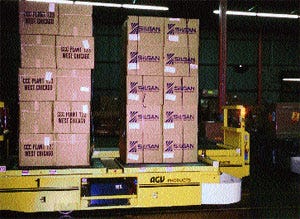March 11, 2015
In the early '80s, Procter & Gamble (P&G) initiated a company-wide program to automate processing operations by employing automated guided vehicles (AGVs) and robotics to handle various repetitive tasks. By the early '90s, most of the AGVs were out of service because of difficulties in keeping them running. However, the Iowa City, IA, plant's AGV system continued to operate, due to the dedication of a few technicians at the site.
In the late '90s, the plant decided to retrofit its existing AGVs, but realized 20-year-old vehicles didn't meet today's high standards. So, P&G brought in AGV Products, Inc. and bought eight new vehicles that could utilize the system's existing guide path. The new AGVs allow P&G to take advantage of advancements in technology, such as the ability to travel "off-wire." As a result of this successful system modernization, P&G is again evaluating AGV systems for other facilities.
Rebecca Burton, AGV Products area leader for the Iowa City plant, says, "The main reason we keep the AGVs is the travel distance between the packaging lines and the warehouse. The AGVs have a 200-ft guide path, and it made sense for an automated vehicle to transfer packaging materials as opposed to a forklift operator.
Dale Hanson, an engineer for P&G's central engineering department in Cincinnati, says, "AGV Products, Inc. convinced us that the Traffic Routing AGV Command Executive [TRACE] control system was flexible enough to meet the Iowa City plant's needs." TRACE is a traffic-control software package that runs on any PC-Windows NT operating system. The software is tied into a programmable logic control (PLC) network and allows control engineers the freedom to simply point-and-click control commands. The software is programmed to request an available AGV to move a pallet; command the vehicle to perform the proper sequences of movement to carry out a request; monitor the status of the AGV throughout the process of handling the request; and prevent vehicles from colliding.
Worldwide operations
P&G has more than 70 processing operations in 140 countries, producing products for the health and beauty, food and beverage, healthcare, and paper industries. Burton says, "We have a total of nine packaging lines and six supply conveyors. During the first shift, everything is running at maximum capacity.
"The primary function of the AGVs are to keep the packaging lines supplied with packaging materials," he adds. "They are constantly moving, either delivering packaging materials, such as bottles and caps, to the line, or removing returns."
|
The AGVs used at P&G's plant in Iowa City are unit-load-type vehicles, capable of handling two pallets at a time. |
The packaging plant operates on a fill-to-order basis. P&G produces batches of a specific product and fills a variety of container sizes. Operators will enter product information into the PLC, and AGVs are then directed to retrieve the desired shampoo bottles and caps from the warehouse. The wrapped, palletized bottles, four to six layers high, are delivered to a conveyor that feeds the packaging line. Operators manually unwrap the bottles and feed them into the conveyor system.
The packaging line will run until the batch of shampoo is depleted. If there are any empty bottles and caps remaining, they will be placed onto a return conveyor. The operator presses a call button that summons an AGV. The operator also identifies whether the return is good–unused bottles/caps to be returned to the warehouse or for scrap.
The TRACE software allows customizing of the host computer's interface, traffic control, routing, inventory control and system and vehicle troubleshooting. Color monitors provide displays of vehicle progress and operation status throughout the plant. The software can call up detailed AGV status, monitor communications, and view and modify moves at any time with a simple point-and-click.
As part of the system's original design, there were areas along the guide path where the vehicle was forced to take long trips to make a U-turn. Conventional AGVs solved this problem by cutting the floor and installing a new guide wire.
Today's AGVs have the ability to travel "off-wire," executing what is called a programmed turn. The vehicle is able to travel a short distance off the guide wire and return to another path, using the vehicle's on-board programming and odometry for guidance. This feature has significantly increased the system's overall efficiency, PD is told. Other improvements include maintenance, improved safety devices and rugged vehicle design. The vehicles can also travel up a 6- to 7-percent grade.
The AGVs used at the P&G facility are unit-load-type vehicles, capable of handling two pallets at a time. They are fitted with two conveyor decks that can operate independently to load or unload pallets from either side of the vehicle. Each AGV has a total load capacity of 5,200 lb.
The vehicles have microprocessor-based control boards that monitor all functions. The controller incorporates digital and analog inputs and outputs for load handling, safety features, and steer and drive functions that permit bi-directional travel and automatic load handling.
More information is available:
Automated guided vehicles: AGV Products, Inc., 704/845-1111. Circle No. 239.
About the Author(s)
You May Also Like



